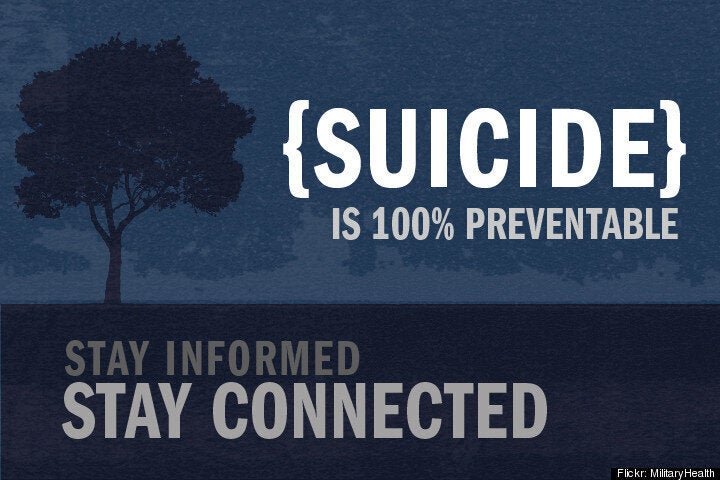
Statistics can be chilling: 34,000 people die by their own hands in the U.S. each year (that's a suicide every 15 minutes, nearly twice that of homicides) and more veterans of Iraq and Afghanistan take their lives than die in combat. But it is the emotional agony that precedes the deadly act for the person and the legacy of lifelong pain that follows it for the survivors that haunts the world of those who take their lives.
Few families are spared -- if not death then suicide attempts and the maelstrom they stir. As a doctor, a psychiatrist, who has treated many patients, I had one man who ran away from a hospital on the day I met him, decades ago, and drowned himself in a freezing river. As a clinical administrator of mental health services and medical director of a psychiatric hospital, I know of many people who have taken the ultimate step and ended their lives. But it was a close relative by a former marriage who hung herself many years ago whose memory to this day still sears my mind and stirs doubt about myself and what might have been done.
Ten years ago, a National Strategy for Suicide Prevention (NSSP) was built on the foundation created by Dr. David Satcher, the extraordinary U.S. Surgeon General who had issued a "Call to Action to Prevent Suicide." A common understanding of suicide was established by the NSSP, advocacy efforts begun, public awareness campaigns launched, local and state prevention plans written and commenced; all the best minds and influential people were involved. Shortly thereafter, the then President George W. Bush ordered the President's New Freedom Commission on Mental Health and its report candidly identified what needed to be done to improve a very broken mental health system in this country.
A very auspicious start. But when we take its measure today, a decade later, we cannot show any evidence that the suicide rate across this country has been reduced. We have not "bent the curve" on self inflicted death. Preventable deaths continue. We can and have to do better.
While no specific, single preventative intervention or technique has worked we have seen notable instances where an impact was made in reducing death by suicide. Two remarkable examples stand out. One is the "Perfect Depression Care Initiative" that began in 2001 in the Behavioral Health Services Division of the Henry Ford Health System, a large Health Maintenance Organization with 200,000 members operating in southern Michigan and adjacent states. Since 2008, they have achieved the perfection they sought: 10 calendar quarters have now passed where not one person has died from suicide. The second example was by the U.S. Air Force in the mid-90s to prevent suicide among Air Force personnel; this initiative was driven by top leadership in the wake of growing deaths and produced an 80 percent reduction, initially, and a 50 percent reduction over time.
In September 2010, recognizing that 10 years had passed with disappointing national results, Secretary Kathleen Sebelius, Health and Human Services, and Secretary Robert M. Gates, Department of Defense, accompanied by former U.S. Senator Gordon H. Smith (now CEO of the National Association of Broadcasters), the Secretary of the Army, John McHugh, other officials, and experts announced a public and private partnership called the National Action Alliance for Suicide Prevention. A second meeting of the Action Alliance met on February 9 to build on the efforts of various workgroups and change the static state of suicide prevention. Many ideas are now in play, so focus, feasibility and leadership will be needed.
What works, then, I ask? Some aspects that pertain to Henry Ford Health and the U.S. Air Force are revealing. What about starting with the setting rather than with any specific intervention to reduce suicide? In other words, first identify an established group to work with. This can be a health plan, a university, a government agency or institution, or a business organization. It can be an organization that has information on all its members, the capacity to reach them all, has clear and committed leadership and is well disposed to innovation. One that can specifically measure what will be done to change practices as well as report on the results while using a quality improvement framework to sustain and enhance any gains that are achieved.
Once the setting, or population is chosen, then is the time to identify specific clinical or social interventions (like depression screening, care paths for the suicidal person or for specific mental disorders, reducing access to weapons, engaging spouses and families, treating alcohol and drug abuse, education campaigns, etc) that would fit each unique setting (or population).
This approach inverts a customary approach to suicide which begins with an intervention and looks to where it can be implemented. Since no single intervention has been proven effective it may be time to turn the field on its head: begin by establishing what contexts offer opportunity for getting something done rather than starting with what can be done.
If we can reduce suicidal deaths by 25 percent in the next 10 years near to 90,000 lives will be saved -- that we know of -- not to mention reductions in serious suicide attempts and the catastrophe that suicidal behavior rains upon a person, family and community. If we can send a man to the moon, we can figure out how to save lives on earth.
.............
The opinions expressed herein are solely my own as a psychiatrist and public health advocate.
Dr. Sederer receives no support from any pharmaceutical or device company.
Visit Dr. Sederer's website at www.askdrlloyd.com - for questions you want answered, reviews and stories.
